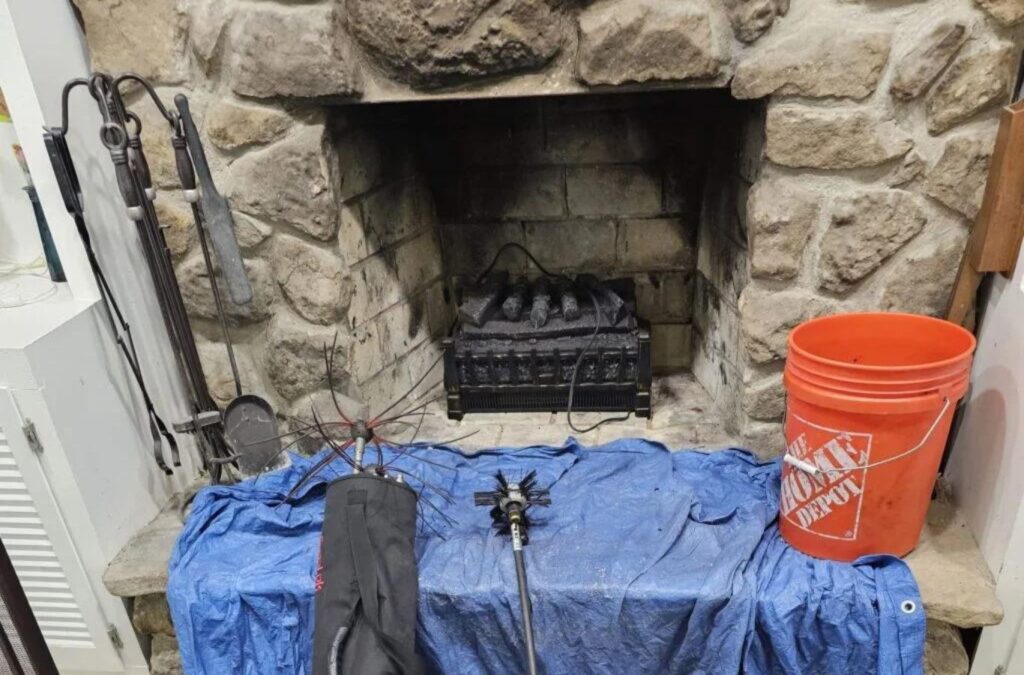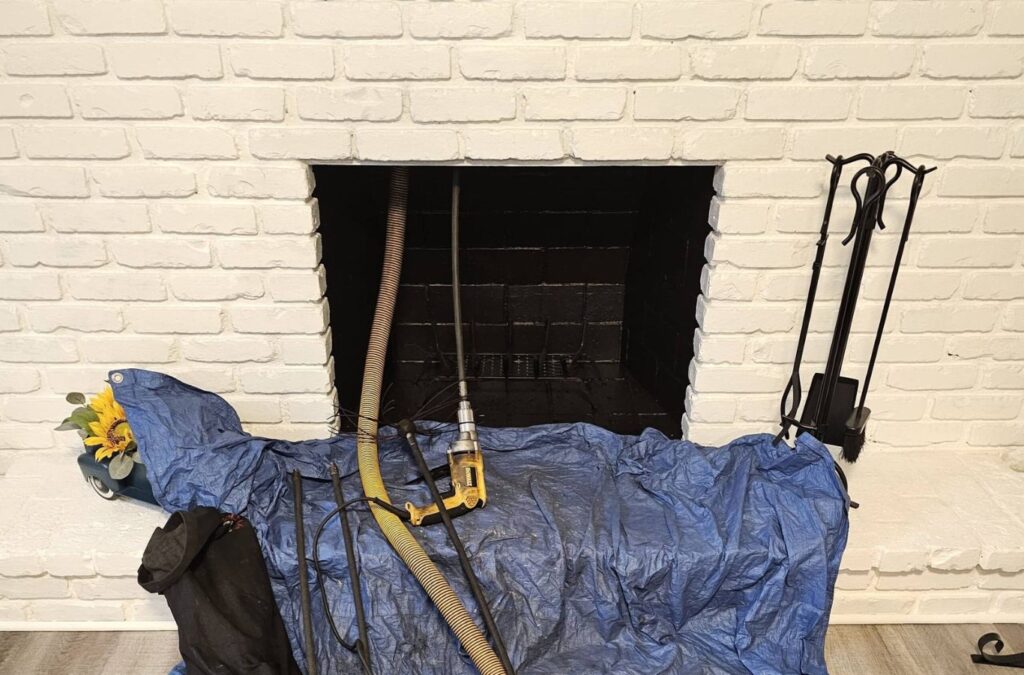A fireplace wood-burning insert transforms traditional fireplaces into efficient, clean-burning, and eco-friendly heating solutions. Designed to enhance the functionality of older masonry fireplaces, these inserts provide more heat while reducing emissions and improving safety. In this article, we’ll delve into how wood-burning inserts work, their components, and why they’re an excellent choice for homeowners seeking an upgrade. Let’s go over how does a fireplace wood burning insert work.

What Is a Wood-Burning Fireplace Insert?
A wood-burning fireplace insert is essentially a sealed, steel or cast iron box that fits inside an existing masonry fireplace. Equipped with a firebox, glass door, air intake, and exhaust system, these units are designed to improve the efficiency of wood-burning fires. Unlike traditional open-hearth fireplaces, which allow significant heat to escape up the chimney, inserts capture and distribute heat effectively into the living space.
These inserts are not standalone fireplaces but enhancements that utilize the structure of an existing fireplace. They come in various sizes, styles, and configurations to fit different fireplaces and aesthetic preferences, making them versatile for many homes.
Key Components of a Wood-Burning Insert
To understand how a wood-burning insert works, it’s essential to break down its main components:
Firebox
The firebox is the heart of the insert, where the wood is burned. Made from durable materials like cast iron or steel, it’s designed to withstand high temperatures and maximize heat retention. Many inserts are lined with firebrick, which helps insulate the firebox and reflect heat into the room.
Glass Door
A heat-resistant glass door encloses the firebox, creating a controlled combustion environment. This door not only enhances safety by preventing sparks and embers from escaping but also helps regulate airflow, ensuring the fire burns efficiently.
Air Intake System
The air intake system manages the flow of air into the firebox, which is crucial for maintaining combustion. Many inserts allow homeowners to adjust the airflow manually, giving them control over the intensity of the fire.
Chimney Liner
A chimney liner is typically installed with a wood-burning insert to ensure safe and efficient venting of smoke and gases. This stainless steel or aluminum pipe runs from the insert through the existing chimney, creating a sealed passageway for exhaust.
Blower System (Optional)
Many inserts are equipped with a blower system to distribute heat more effectively. The blower draws cool air from the room, passes it over the hot surfaces of the insert, and pushes warm air back into the living space.
How Does a Wood-Burning Insert Work?
Wood-burning inserts are engineered to optimize the combustion process and retain as much heat as possible. Here’s a step-by-step look at how they function:
Starting the Fire
To start a fire, you’ll place logs and kindling inside the firebox and ignite them. The glass door is then closed, and the air intake is adjusted to provide the optimal amount of oxygen for combustion.
Combustion
As the fire burns, the firebox retains heat while the air intake system controls the flow of oxygen. This controlled environment ensures a more efficient burn, producing more heat and less smoke compared to an open fireplace.
Heat Distribution
The heat generated by the fire is radiated into the room through the glass door and the metal body of the insert. If a blower is installed, it circulates warm air throughout the space, ensuring even heating.
Smoke Venting
The chimney liner connected to the insert ensures that smoke and gases are safely vented outside. This sealed system prevents drafts and reduces the risk of chimney fires.

Advantages of a Wood-Burning Insert
Wood-burning inserts offer several benefits over traditional fireplaces, making them a popular choice for homeowners seeking efficiency and sustainability. Knowing how does a fireplace wood burning insert work is not the only advantage here.
Enhanced Heating Efficiency
Traditional open-hearth fireplaces lose up to 90% of their heat through the chimney. In contrast, wood-burning inserts are designed to retain and distribute heat effectively, with efficiency ratings often exceeding 70%.
Reduced Emissions
Modern wood-burning inserts meet stringent EPA standards for emissions, producing significantly less pollution than traditional fireplaces. This makes them an environmentally friendly choice for heating your home.
Cost Savings
By improving heating efficiency, wood-burning inserts can reduce reliance on central heating systems, leading to lower energy bills. Additionally, wood is often a more affordable fuel source than gas or electricity.
Improved Safety
The sealed design of a wood-burning insert minimizes the risk of sparks, embers, and creosote buildup, which are common causes of chimney fires.
Aesthetic Appeal
Wood-burning inserts come in various styles and finishes, allowing homeowners to choose a design that complements their décor. The large glass doors also provide a clear view of the flames, creating a cozy ambiance.
Installation Process of a Wood-Burning Insert
Installing a wood-burning insert requires professional expertise to ensure safety and compliance with local building codes.
Evaluating the Existing Fireplace
Before installation, a technician will inspect the existing fireplace to ensure it’s structurally sound and compatible with an insert. Any necessary repairs, such as fixing damaged masonry or addressing chimney issues, are completed at this stage.
Selecting the Right Insert
Choosing the right insert involves considering the size of the existing fireplace, the heating needs of the home, and personal aesthetic preferences.
Installing the Chimney Liner
A chimney liner is essential for venting smoke and gases safely. The liner is installed from the top of the chimney and connected to the insert, creating a sealed venting system.
Positioning and Securing the Insert
The insert is carefully placed inside the existing fireplace and connected to the chimney liner. It’s then secured in place, ensuring stability and proper alignment.
Testing and Operation
Once installed, the technician tests the insert to ensure it operates correctly and safely. They’ll also provide instructions on how to use and maintain the unit.

Maintaining a Wood-Burning Insert
Proper maintenance is crucial for the longevity and performance of a wood-burning insert. Regular cleaning, inspection, and servicing will help keep the unit in optimal condition.
Cleaning the Firebox
Ashes should be removed from the firebox regularly to prevent buildup. Always wait until the firebox is completely cool before cleaning.
Inspecting the Chimney Liner
The chimney liner should be inspected annually for creosote buildup and signs of wear. Professional cleaning is recommended to reduce the risk of chimney fires.
Checking the Blower System
If your insert has a blower, clean or replace the filters as needed to ensure efficient operation.
Conclusion
A fireplace wood-burning insert is an excellent investment for homeowners looking to enhance the efficiency, safety, and eco-friendliness of their existing fireplaces. By understanding how these inserts work and maintaining them properly, you can enjoy a warm and inviting home during the colder months.
Green & Clean Home Services provides professional fireplace cleaning and maintenance in Northeast Ohio, ensuring your wood-burning insert and chimney operate safely and efficiently. Contact us today to learn more about our services. We hope this helps you understand how does a fireplace wood burning insert work.


